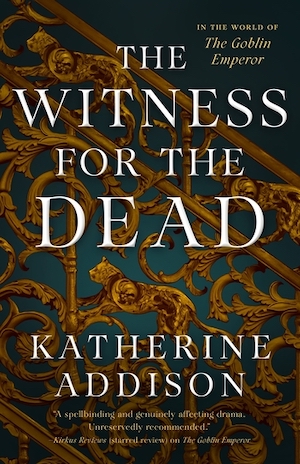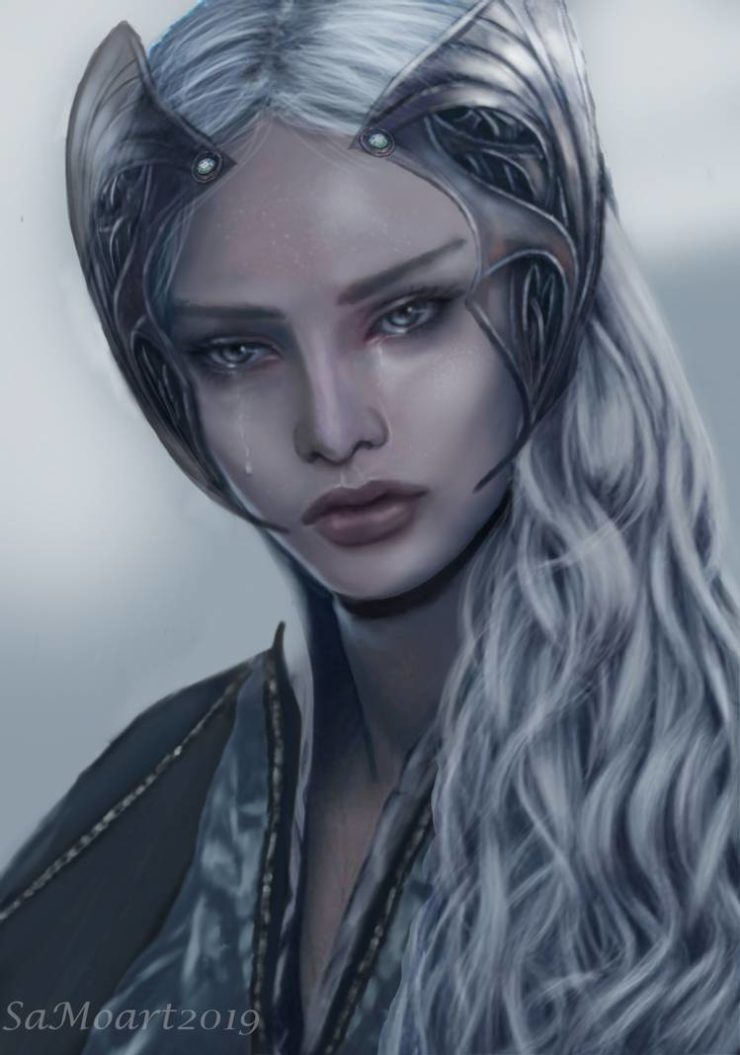In this biweekly series, we’re exploring the evolution of both major and minor figures in Tolkien’s legendarium, tracing the transformations of these characters through drafts and early manuscripts through to the finished work. This week’s installment takes a look at the story of Nienna, a queen of the Vala who mourns the hurts of the world around her.
Most weeks, making a decision about which Tolkien character to highlight is difficult, at best. There are just so many to choose from, so many fascinating stories that are just calling out to be told. This week, though, the answer was simple. It’s been a difficult year for many of us. We have endured long separations from those we love; we have lost much, suffered much, and grieved much. For many of us, that grieving process will be long, and it won’t go away with the coming of a new year, the end of quarantine, or even the end of the virus. Even the holidays have a muted cast this year. Who better, then, to escort us through the final shadows of 2020 than Nienna, Vala of sorrow?
Tolkien’s original conception of Nienna was… well, dark. In “The Coming of the Valar” she is a death-goddess, the spouse of Mandos (in place of Vairë the Weaver), who manufactured tears from “salt humours” and sent black clouds of sorrow and despair over the world: “despairs and hopeless mourning, sorrows and blind grief” (The Book of Lost Tales I, hereafter BLT1, 78). Her primary name, Nienna, derives from the root nei, which means “tear” (The Lost Road, hereafter LR, 419). “Many other names has she that are spoken seldom,” the narrator says, “and all are grievous, for she is Núri who sighs and Heskil who breedeth winter, and all must bow before her as Qalmë-Tári the mistress of death” (BLT1 66). Her halls are named for herself: in early tellings, she was called Fui, “night” (LR 426), or Fui Nienna; her dwelling is called Fui. Even it is dark and disturbing: “before her black chair burnt a brazier with a single flickering coal, and the roof was of bats’ wings, and the pillars that upheld it and the walls about were made of basalt” (BLT1 78). Indeed, her characterization, and that of her home, has more in common with the Sauron of The Silmarillion, and with the bat Thuringwethil, than with the figure of gentle sorrow and patience that appears in the later stories.
And not only that—according to “The Coming of the Valar,” it is Nienna, and not Mandos, who is the judge and doomsman of the Valar. When Men and Elves die, they journey to Fui Nienna’s halls on the fringes of Valinor: there is only one path, “and it is very dark; yet it is very short, the shortest and swiftest of all roads, for Mandos made it and Fui set it in its place. Qalvanda is it called, the Road of Death […]. Twofold is it, and one way tread the Elves and the other the souls of Men, and never do they mingle” (BLT1 240).
Even more importantly, Nienna’s position as judge reveals a fascinating early conception of the fate of Men, before Tolkien decided to shroud that road in mystery and silence (BLT1 95). In the words of Christopher Tolkien, Fui Nienna is the one who judges who belongs in “Hell,” who in “Heaven,” and who in “Purgatory” (BLT1 97). “The Coming of the Valar” says that when “Slaughters and fires, hungers and mishaps, diseases and blows dealt in the dark, cruelty and bitter cold and anguish and their own folly brings them” to the halls of Fui, she “reads their hearts” (BLT1 78). Then, she judges them:
Some then she keeps in Mandos beneath the mountains and some she drives forth beyond the hills and Melko seizes them and bears them to Angamandi, or the Hells of Iron, where they have evil days. Some too, and these are many, she sends aboard the black ship Mornië, who lieth ever and anon in a dark harbour of the North awaiting those times when the sad pomp winds to the beach down slow rugged paths from Mandos. (BLT1 78)
The ship, Mornië, takes Men to the light and joy of Valinor, to dwell in bliss with the Valar until the end of time. Of course, Tolkien eventually removed this from the tales about Nienna, not least because he felt it encroached on Catholic doctrine; as we know, the fate of Men is hidden, though death is their Gift from Ilúvatar.

It’s also important to note that at this early stage, neither Mandos nor Nienna have any kind of pity or graciousness to their characters. According to “The Coming of the Elves,” “Mandos and Fui were cold to the Eldar as to all else,” and they resist mightily the plan to bring the Elves to Valinor (BLT1 125). Furthermore, Fui Nienna and Mandos do not come to the feast during which Melkor murders the Two Trees and steals the Silmarils—instead, they remain in their respective dark halls, brooding and, in the case of Nienna, spinning sorrow (BLT1 159). Fui and Mandos return again to protest the creation of the Sun, for they were angry, saying it dispelled secrets and made the world “a place where no quiet or peaceful shadow could remain” (BLT1 212). The role of protest was later given to others (in the next version of the story, it’s Nienna and Lórien), but it serves here to emphasize just how cold and hostile Nienna and Mandos are. They resist light, joy, and companionship, and in their sorrow and shadow there is no hope or kindness.
An early draft of the Quenta begins to revise Nienna, making her significantly less dark and terrible, though still fearful and powerful: now, “Pity is in her heart, and mourning and weeping come to her, but shadow is her realm and night her throne” (The Shaping of Middle-earth, hereafter SM, 96). That qualifier, “but,” insists that readers acknowledge that Nienna is still to be reverenced and feared in her solitude and her position as judge. Regardless, she is changing. An early revision of the Quenta introduces the scene in which she waters the Trees of Valinor with her tears (SM 98).
Buy the Book


The Witness for the Dead
In the second version of the Annals of Valinor, Vairë wife of Mandos is introduced, and Nienna becomes an independent Vala (SM 344). With this transformation, she gains brothers: Manwë, Mandos, and Melkor (SM 312). (Mandos is removed from the sibling group in The Lost Road [122].) This relationship moves Nienna to pity when Melkor pleas for pardon, and her prayers move Manwë to leniency and forgiveness rather than cruelty (SM 314). Naturally, it doesn’t turn out well, but the situation does illustrate an important growth in Nienna’s character: no longer is she the hard, taciturn goddess of judgment and death. Instead, her knowledge of sorrow and pain moves her to mercy and grace.
A draft of the Quenta Silmarillion adds again to Nienna’s description:
She dwells alone. Pity is in her heart, and mourning and weeping come to her; shadow is her realm and her throne is hidden. For her halls are west of West, nigh to the borders of the World and the Darkness, and she comes seldom to Valmar, the city of the Gods, where all is glad. She goes rather to the halls of Mandos, which are nearer and yet more northward; and all those who go to Mandos cry to her. For she is a healer of hurts, and turns pain to medicine and sorrow to wisdom. The windows of her house look outward from the Walls of the World. (LR 226)
This description is so, so significant for Nienna’s development. First, she understands solitude and it has taught her patience and listening. The qualifying “but” is also gone—which means that her capacity for pity is no longer in opposition with the fact that “shadow is her realm.” Instead, they come together, as compliments rather than contradictions. Instead of being judge and doomsman, she is now a healer—someone who has grown from her experiences of sorrow and pain and uses it to soothe the hurts of those around her. She is the check to Mandos’s sense of justice; she reminds him of the exigence of mercy.
Importantly, but unsurprisingly, Nienna’s ability to sympathize and empathize stems from her commitment to listening. According to a note to the Annals of Aman, Nienna spent far longer listening to the Music of Ilúvatar than she did actually singing. “Therefore,” the note says, “she was rich in memory, and farsighted, perceiving how the themes should unfold in the Tale of Arda. But she had little mirth, and all her love was mingled with pity, grieving for the harms of the world and for the things that failed of fulfillment” (LR 68).

I used to find Nienna’s role relatively pointless—it seemed to a younger me that she was simply choosing to wallow in her sadness, never attempting to make a change. To a certain extent, that’s true—but at the same time, I no longer think that of her. The sorrows that she carries are not her own, but those of the world itself. It is not that she wallows, but rather that she allows sorrow and sadness a place to exist, to be acknowledged. For Nienna, sadness is permissible because the world is messed up and broken and sometimes, things just hurt and nothing can be done. Nienna sits with sorrow and doesn’t try to dismiss it. Instead, because she has acknowledged and truly felt it, she is able to find and offer healing.
That’s not all. For Nienna, sorrow isn’t a weakness. It’s a necessary part of the world, keeping us sane, grateful, and merciful. “In the use of Justice there must be Pity,” she says, “which is the consideration of the singleness of each that cometh under Justice” (LR 241). In other words, the appropriate exercise of justice takes into account the pain and sorrow and brokenness of those who have done wrong. Justice is not whole without grace. She begs us to listen to the stories around us, to recognize that we are not the only ones who have been hurt. Healing of any sort cannot be accomplished by ignoring the wounds or rushing ahead before we are well again. Nienna understands this, and she creates a place in which sorrow can exist without shame or derision.
One way to understand the power of Nienna’s role is to take a look at one of her pupils. It is said of Olórin, better known to many of us as Gandalf, that “his ways took him often to the house of Nienna, and of her he learned pity and patience” (Silmarillion 18). This training prepared Gandalf to weather the storms of the fight against Sauron. It taught him to respect and cherish the scars of the people he helped. Because he understood sorrow, he could kindle hearts to hope: “His triumph was in the uprising of the fallen, and his joy was in the renewal of hope” (LR 203).
Nienna’s commitment to making space for sadness even in the midst of joy made Gandalf’s work possible. She isn’t ashamed of her grief; indeed, her acceptance of it clears the way for renewal. After the death of the Two Trees, it is said that “Nienna arose, and she went up onto the Mound; and she cast back her grey hood, and her eyes shone like stars in the rain, for her tears were poured out, and she washed away the defilements of Ungoliante. And when she had wept she sang slowly, mourning for the bitterness of the world and all hurts of the Marring of Arda” (LR 293).
Nienna invites us to find wholeness by accepting the grief that will always be part of the world we live in. If you are grieving, she seems to say, I have a place for you. Rest in the silence and the cool shadows. Weep, and your tears will bring healing, and I will hear and honor you.
Megan N. Fontenot is a dedicated Tolkien scholar and fan who is abundantly thankful for Nienna’s role in Arda and the example of her graciousness. Catch her on Twitter @MeganNFontenot1 and feel free to request a favorite character while you’re there!










